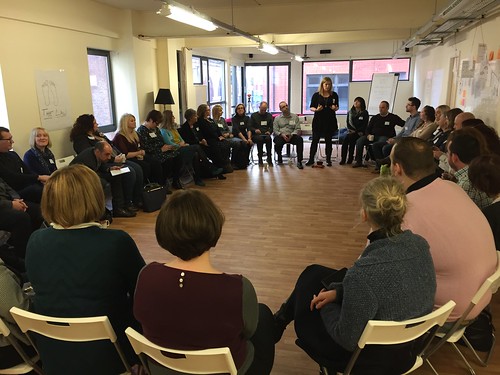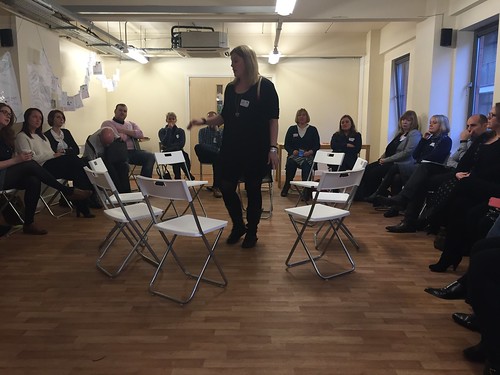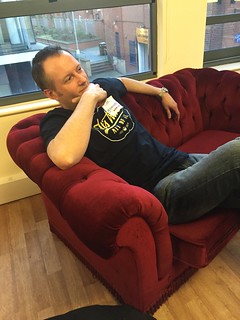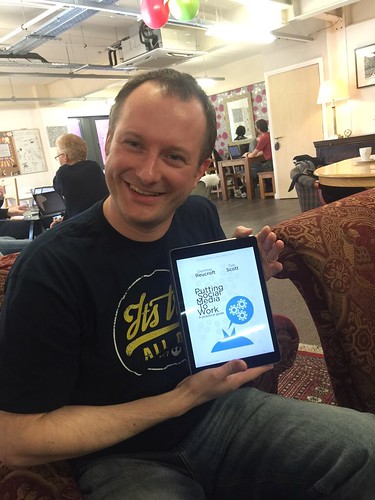The L&D Connect Unconference – 11 February 2016
Yesterday I had the great pleasure of attending the L&D Connect Unconference, held in the brilliant surroundings of Manchester’s Ziferblat. Once I got into the warm, the first thing I noticed was the funkyness of the venue: a co-working space where you pay 6p per minute and can have unlimited coffee, tea and cake. What’s not to like? The next thing I noticed was a crowd of L&D people – a great bunch of some familiar and some not-so-familiar faces. Our first task for the day was to create a name badge and a bigger sheet of info about us comprising of our names, Twitter handles, a self-portrait and our motto. Here’s my effort:
I immediately got chatting to several people I already knew and a number of people I didn’t. I also bumped into people whose faces I knew from Twitter but had never met. It was a great start to the day.
Then we convened in the main meeting room – I was the last one in as I couldn’t resist “one more” coffee… But it meant I got this atmospheric shot of the whole room.
You can see Julie Drybrough standing and setting out the rough plan for the day – and to be fair, as plans go, it was very sketchy on detail. We had some time slots, some post-its and a room full of people eager to talk about L&D. That was about it. It was over to Kev Wyke to explain how OpenSpace works. I won’t go into detail here but I found this useful guide which pretty much models what we did. You can also see some of the description that we were given “live” in the Twitter feed from the day, some of which I have curated in this Storify.
After a while, we had some suggestions for topics and we needed to put the agenda together. Those who had suggested topics were invited up and as a group, we came up with the day’s plan. It looked like this:
A bit different from the usual conference-style glossy brochure! But that’s why this was an Unconference.
With that out of the way, there was time for coffee and cake (of course) before we hit our first groups. The person who suggested the topic was the “convenor” who stayed put to top and tail the conversation – not facilitate. Participants could either stay in the same group (“settlers”), or move between groups (“butterflies”), following “the law of two feet” – in other words, if you want to move on for whatever reason you have the absolute right to do so. Others moved between groups to cross-pollinate ideas (“bumblebees”). I turned out to be a settler as I found I liked the time and space to focus on one subject and get into the detail.
I’ve put my notes from the sessions at the end of this blog so you can see what we got up to.
After that it was sessions, coffee and cake – with a break for lunch – until our final session where we all came back together again for a different style of facilitation, a fish bowl. There are various different versions of the fish bowl approach – here’s Wikipedia’s take on it for more info. As you can see from the picture below, there were a number of chairs placed in the middle of the circle. Once we agreed the topic, people were invited to sit in the inner circle. A few of us did. We then had a discussion on the subject in hand, observed by everyone else. Only the people in the circle could speak. At any point you could either leave the inner circle voluntarily or another member of the group could tap you on the shoulder as a request to take your place. As it turned out, we pretty much left an empty chair throughout the discussion of our own accord so anyone could join at any point and one person would deselect themselves.
It’s one of those things that’s harder to explain than it is to do! I found it an interesting alternative to trying to get a group discussion going with such a large group.
And that was the final activity of the day. Oh actually, there may have been some unison humming (you had to be there) and some more coffee and cake too. so what did people get out of the day? Well we went round the group to answer that very question and I made a quick note of what everyone said:
- L&D isn’t dead!
- The generous behaviour of everyone in the conversations
- Are we embracing digital communities as an organisation?
- The concept of an unconference
- I like the unstructured structure of the day
- The power of co-creation with great people
- The power of “just enough structure”
- The topic of technology is massive – there isn’t a space where those questions can be answered
- Enjoyed talking and the cake!
- The process and the passion of everyone in the room
- Ignite a spark that had gone dead
- Connections
- Hanging around with nice people and reflections on some issues that are agitating me
- Social media
- This situation makes networking much easier for me
- Reassured that there aren’t any golden answers I’m missing
- Been a joy to meet so many people I learn from on Twitter every day
- Spend time with people doing L&D stuff
- We all bring what we can and whatever it is it’s good
- Have conversations of more than 140 characters
- New insight on facilitation and definitions
- Great conversations, fascinating perspectives, good giggles
- I am an awesome hummer! But have the conversations moved on in the past 3 years?
- Connections contributions creativity challenges
- Lovely people. Real faith in this process.
- There aren’t any other conversations like this happening in HR/L&D
- I got to pop my Twitter cherry!
I described the day as having been like “real-life Twitter”, which is exactly how I found it: short, sharp, engaging conversations with brilliant people, some of whom shared my perspective and some of whom brought different approaches. There’s a lot more I need to reflect on.
As someone who doesn’t really consider themselves “L&D” (I’m an HR generalist!), some of the debates about the profession and its role within businesses were interesting – I recognised a lot of the angst around changing requirements, increased use of tech and proving the value of the work we do as big issues affecting HR too. But most of all I recognised the passion, commitment and desire of the people in the room to make a difference to “work” somehow, some way.
Would I recommend the Unconference format? Very much so, yes. As an antidote to the stale conference presentations (which border on sales pitches) that we’ve all sat through, an opportunity to share what you know and learn a lot more, to meet some fantastic people and – of course – to drink a lot of coffee and eat your body weight in cake, the unconference format is a great experience.
My “notes and quotes” from the sessions I attended
First session: How do we build effective learning communities?
- “Nothing had changed – everyone was doing the same thing. We need more technical-based learning.”
- “We need to look at different ways of learning”
- Etienne Wenger – looking at creating value in communities of practice.
- Communities of practice don’t just happen by themselves
- You still need people to connect in the first instance to create trust – and at least some familiarity with the technology
- It’s never going to be “one size fits all”‘ it’s not even a “thing” any more
- There’s the design bit and then there’s the ‘how do we influence’ bit?
- Learning community often introduced for a very specific purpose – eg a long term leadership programme – tier 1. Then tier 2 is where people are starting to reflect in that space and add TED talks etc. Tier 3 – not every community will or should ver get to this – when people share challenges and start to be more vulnerable with each other. If you can get to that level within the programme, there’s a community of practice that will continue there beyond it.
- What conditions create that? <- this is a key question
- Real life needs to be reflected in the virtual space and vice versa
- Need to be clear that this is going to happen – we’re creating a space. Tell them.
- How you come across is so important – how do people experience you when you’re not in the room?
- Load of face to face stuff that can support that
- Need to be really clear about the learning that’s possible
- This is where Julian Stodd‘s Social Age stuff comes in
- Beautiful technology that is easy to use really make the difference
- The key word is “useful“! Need content to be relevant, accessible (easy) and not buried in 10 things that aren’t relevant. Activity stream can be a bugbear.
- Different platforms are needed for different job roles. Eg some people are Facebook fans. No one platform fits all.
- eg of Vodafone – have a platform that enables content to be delivered direct to people’s devices but can also allow management to input info eg “so and so greeted the customer properly etc” – performance data
- Still need space for face to face reflection
- Doesn’t all need to be contained within one place – not necessarily an LMS. You don’t go to Facebook for the latest movie trailer, you go to YouTube. People are perfectly capable of choosing the appropriate app – alternatives exist to the one stop LMS. Pick best in breed apps that do one thing really well.
- How do you keep the community vibrant and avoid the echo chamber? You might end up with the same people using it and stagnating…
- It’s our role to build confidence and capability in doing things differently. Some of it will work and some won’t – we’ll learn from that. Communities will be born out of that.
- Part of it is about creating a safe space. But does that not mean that there’s a problem – challenging someone’s beliefs could be seen as “that’s not what this community is about”. Someone having their fundamental beliefs challenged might cause them to disengage. Is that any different to what happens in face to face? It’s how you approach the challenge.
- At times, what you know to be true flips and that’s ok. But you need to build your own argument around it.
- The slope of enlightenment v the trough of disillusionment
- How do you measure impact?
- There are community metrics
- Or you can asked things like “How has this helped you?” And “how much time did it save you?” And you can put £ signs agains that!
- Is it as simple as: Do I feel different? Am I doing something different?
- User leaderboard = bad idea, encourages the wrong things. But users to get likes, shares etc from other users is a good thing
- Pictures of cats will be interacted with a lot – but they don’t add much value. There might be a long post that is a bit obscure but it changes the behaviour of 5 people – that’s valuable
Here’s Shaun Gagie giving a quick video summary which went out live on Periscope at the time:
Second session: Using Twitter for learning
To be completely honest, I didn’t take notes during this session, partly as I was in “broadcast” mode a bit and partly because I was wrapped up in the conversation. So I’ll just put this picture here instead.
And if you’re wondering what I’m holding up and looking so cheesy about, visit this link to Amazon…
Third session: “No budget, big impact” (with a side-order of “proving our worth”)
- We hire great people, then bring in external trainers!
- Using internal knowledge and skills
- Mentoring
- Businessballs
- It’s a cultural thing – moving people on to free initial websites is a cultural change. Can market it in the right way. What would you normally do? Go to google… The L&D dept have gone though a filter process. Have to change hearts and minds to a different way of working. We default to what we know.
- “If it’s free, it’s no good” is still a common view
- We all go to TripAdvisor and take the view of a total stranger
- 100 ways to learn – sharing. Futurelearn – millions of free courses on Coursera.
- MOOCs – peer to peer review – “the best learning experience ever”. Look at MOOC-list.com
- Can search by topic and see what is coming up
- Connections – use the connections people who work for you have to share insights and learning
- Cafe style learning – laminated cards to enable some learning
- Mindsets shift – the individuals taking responsibility for their own learning.
- This would work for behavioural content and where organisations are looking to build client base, but what about training that is regulated/quality assured?
- Curation!
- If we’re looking at ROI, it’s easier to start with the business need. Are we measuring the right things? Need to start with the right things – agree what the outcomes will be. If you’re measuring “was the learning nice?” it’s measuring for measuring’s sake. Need to ask “what metric are we looking to change?”
- L&D need to infiltrate the organisation! Understand what is going wrong, report back and then use that info. An “anthropological” approach!
- “What is the point in doing something if it doesn’t have an impact on performance somewhere down the line?” How do we know whether what we do makes a difference? How do you know whether what you did made any difference whatsoever? We should have controlled trials. Do we not run control rolled trials because we are scared we might find out what we do makes things WORSE? Eg of administering steroids for head traumas – was the standard treatment with entirely justifiable logic but trials eventually showed it was killing people!
- Finding people who are receptive to what we bring rather than not. The are people who want to get on and do a better job – if it works for em, maybe it can work beyond that. Why try to do things with people who are resistant?
- Sometimes we invest so much time in the design that we can’t stop a project once it’s started
- Research has shown that there’s a correlation between the amount of. Money spent on leadership development and the dissatisfaction with it (more money = less satisfaction)
- Run your own unconferences!
- Learning exchanges – I’ll give you 3 hours of this if you give me 3 hours of that





0 Comments on “The L&D Connect Unconference – 11 February 2016”